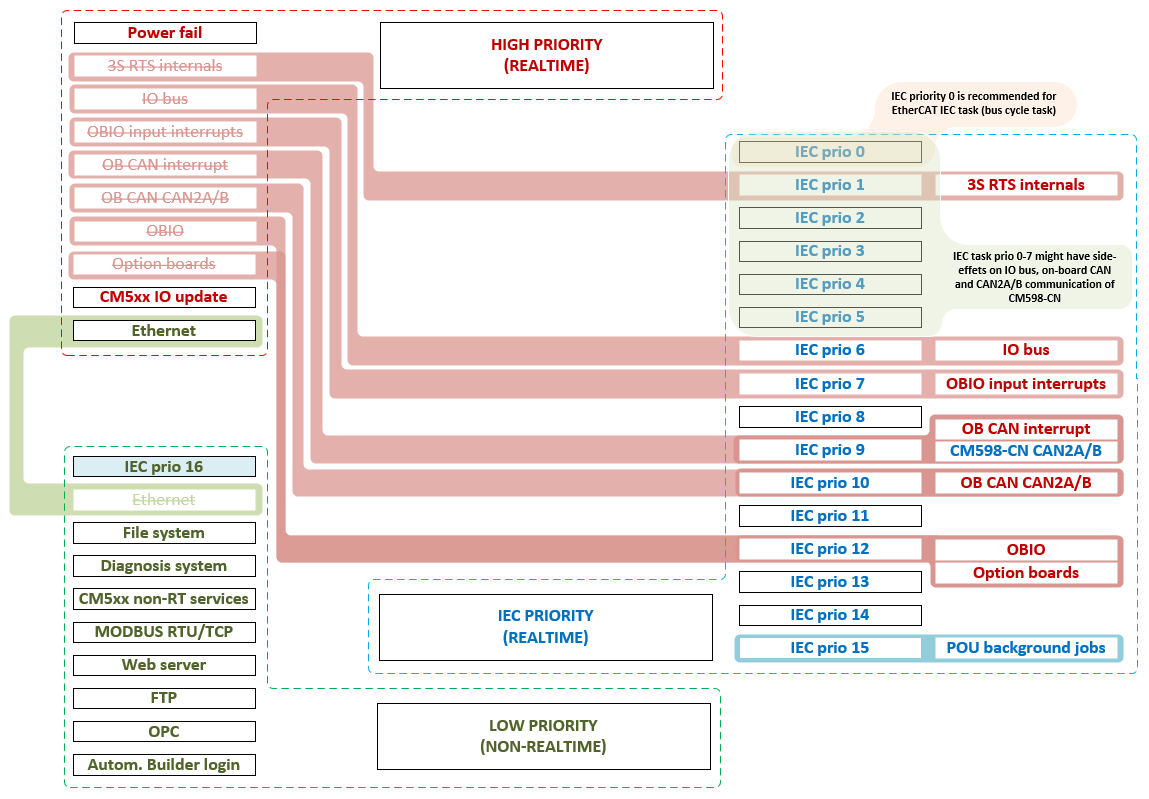Schema “Onboard EtherCAT” is intended for users who intend to make use of the EtherCAT master protocol, configured at one of the available onboard Ethernet ports of the corresponding PLC.
Due to the special requirements of EtherCAT, it’s necessary to modify the configuration of system components related to onboard Ethernet, and thus provide a low-latency Ethernet port. In addition to that, priorities of various functionality are adjusted to reduce negative side-effects on the EtherCAT IEC task and achieve best possible performance.
Features and their priorities
The following diagram shows the changes the schema applies to the available features of the PLC. The primary goal of this schema is to reduce the number of tasks which are capable of interrupting or delaying the Ethernet IEC task, while providing as much flexibility as possible. By making use of the priority range of IEC tasks, users can decide whether existing IEC tasks will influence the corresponding features.
-
Use IEC priority 0 for the EtherCAT IEC task and a priority lower than 0 for all other features to avoid negative side-effects on EtherCAT.
-
Use IEC priorities 1 to 5 for functionality which is more important than high priority features like IO bus or onboard I/O.
-
To ensure that a high priority feature isn’t influenced by any IEC user code (besides of EtherCAT), use an IEC task priority which is lower than the priority of the corresponding feature.
It is not forbidden to make use of IEC task priorities which are assigned to other PLC functionality.





NOTICE

Be careful when using this schema to avoid unwanted side-effects on features other than EtherCAT, caused by violation of individual timing constraints or requirements!
I/O bus must be able to refresh all connected S500 I/O devices within 20 ms. Otherwise, an exception will be raised which will lead to a
stop of the application. Use PLC shell command io-bus desc to dump information on the bus timing. The output contains information on the IO
bus cycle time:
--- I/O bus information —
Baud rate [baud]: 1714286
Min. cycle time [us]: 1037
Max. cycle time [us]: 10936
Last cycle time [us]: 1567
The maximum cycle time must be well below 20 ms to ensure that the system runs stable and won’t raise a timeout exception error.
If the cycle time reaches the limit, try to reduce the amount of code executed by IEC user tasks of higher priority than I/O bus or adjust task priorities if possible.
Low latency port
Besides the adjustment of task priorities, schema “Onboard EtherCAT” also changes the low level Ethernet driver configuration to offer a dedicated low latency port to the user.
|
PLC type |
ETH1 |
ETH2 |
|---|---|---|
|
PM50xx |
Low latency |
Maintenance and visualization |
|
PM56xx |
Maintenance and visualization |
Low latency |
The other port remains on low priority to minimize the impact on the activity of the v protocol. It is intended for login (Automation Builder), visualization services or similar (non-real-time) activities.
When configuring eCo CPU “Onboard EtherCAT” parameters, the ETH1 interface is set to the IP address 0.0.0.0. After switching to a different communication scheme than “Onboard EtherCAT”, IP configuration of the Ethernet port used for Onboard EtherCAT remains invalidated (IP address 0.0.0.0). It needs to be re-applied by the user should the port be required by the new application.
The “Onboard EtherCAT” functionality is only usable/visible for the eCo CPU from SystemFW 3.7.0.





